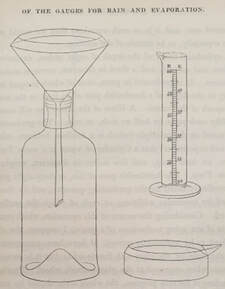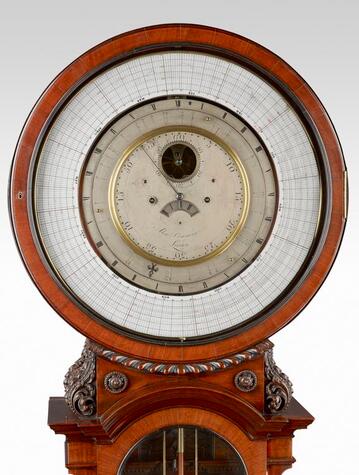Luke Howard's measuring instruments
The daily weather recordings made by Luke Howard were made at his workplace in Plaistow and his homes in Stratford and later Tottenham. The measurements he took were of the pressure, temperature, humidity, precipitation and evaporation. Unfortunately he had no means of recording wind velocity except by direct observation.
The rain gauge and the glass measuring cylinder, made by Richard & George Knight, 45 Foster Lane, Cheapside, London around 1818, are two of the earliest such instruments for measuring rainfall. The gauge consists of a glass bottle and copper funnel, as well as the measuring cylinder. They were commissioned by Luke Howard and mentioned in his book The Climate of London. Both instruments are in the Science Museum in London.
Barograph clock: measuring air pressure
|
Science Museum Press Release - 7 July 2016:
This exquisite Georgian clock becomes the Science Museum's most precious acquisition. A rare Georgian clock, capable of recording changes in air pressure and used at the dawn of climate science has been acquired for the nation by the Science Museum. Dated 1766, the barograph clock is one of only four of its type that highly-regarded London clockmaker Alexander Cumming is known to have constructed. It was used by renowned meteorologist Luke Howard to conduct some of the world’s first urban climate studies. Luke Howard purchased the clock in 1814 and used it for observations of atmospheric pressure at his homes in London and Ackworth, a crucial project in the emergence of climate science. The data from the barograph traces, accompanied by notes on global weather events and descriptions of the clock, were published in the book Barometrographia in 1847. Howard's life's work has earned him the nickname 'the father of scientific meteorology'. Inside the imposing 7ft 2in-high decorated case, thought to be made by famed London cabinet maker Thomas Chippendale, is a barograph mechanism used for measuring air pressure. The barograph comprises two tubes of mercury in which a float rises and falls as atmospheric pressure changes. This data is recorded on the clock dial, which rotates once a year. "Nothing beats the marriage of an exquisite object and an enquiring mind. We are delighted to have been able to save the barograph clock so that we can share the story of Luke Howard’s contribution to climate science with future generations." Ian Blatchford, Director of the Science Museum Group
The clock barometer stood in my house at Tottenham Green till the Third Month, 1828, when I removed it to my present residence at Ackworth. Luke Howard |
Barograph clock in carved mahogany case
|
The data from the barograph traces, accompanied by notes on global weather events and descriptions of the clock,
were published in the book Barometrographia in 1847.
were published in the book Barometrographia in 1847.
Barometrographia 1815
Twenty Years’ Variation of the Barometer in the Climate of Britain… by Luke Howard; London, 1847.
Twenty Years’ Variation of the Barometer in the Climate of Britain… by Luke Howard; London, 1847.
Reading Howard’s writings, you sometimes get the sense that he didn’t fully appreciate the significance of his own work. In a letter to John Herschel in 1847, he bemoaned the fact that meteorological science was becoming an increasingly technical field to which he would no longer be able to contribute: ‘The awful shade of Astronomical precision … appears now to be gathering upon the subject; and much, if not most part of the labour hitherto bestowed upon it by such simpletons as the writer, may be looked upon as thrown away’. Perhaps Howard was concerned that public interest in meteorology would evaporate if the subject became too technical. In reality, I think he had nothing to worry about. After all, we will never stop complaining about the weather.
Jon Bushell, Royal Society blog post
Jon Bushell, Royal Society blog post
Learn more about Luke Howard's weather recording in Climate of London and his discovery of the Urban Heat Island effect.








